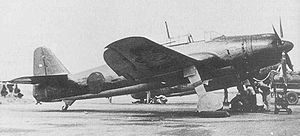Aichi B7A
| Aichi B7A Ryūsei | |
|---|---|
 Aichi B7A Ryūsei |
|
| Type: | Torpedo bombers |
| Design country: | |
| Manufacturer: | |
| First flight: |
May 1942 |
| Commissioning: |
1944 |
| Production time: |
1944-1945 |
| Number of pieces: |
114 |
The Aichi B7A Ryūsei ( Japanese 流星 , dt. "Shooting Star"; allied code name Grace ) was the last and most powerful carrier-based horizontal bomber , dive bomber and torpedo bomber of the Japanese Navy during World War II .
development
The development goes back to a specification from 1941 to complement the Nakajima B6N and Yokosuka D4Y and later replace them. The aircraft had excellent flight characteristics in terms of speed and maneuverability. The chances of survival of an Aichi B7A2 (for a Japanese airplane from 1945) were very high. The bomber also had self-sealing fuel tanks , which the above-mentioned predecessors lacked, which is why they suffered high losses. The folding gull wing wings were characteristic, reminiscent of the German Ju 87 "Stuka" and even more of the American F4U-1 "Corsair" .
The first prototype flew in May 1942. Due to engine problems , bombardment and the Tōnankai earthquake at the production facility, series production was delayed until May 1944. When the machines were ready for the front in 1945, the theaters of war had already moved so close to the motherland of Japan that it made no sense to use the aircraft carriers that had remained or were newly completed in 1945. Although the pattern was still being tested for carrier use, it was only used from land bases. In the end only about 114 aircraft were completed (9 of which were prototypes B7A1 and 105 B7A2), which could no longer make a significant contribution to the course of the war. 25 of the 105 B7A2 were built by Dai-Nijuichi Kaigun Kokusho in Omara.
A more motorized version B7A3 with a Mitsubishi MK9A - radial engine with 1,620 kW (2,200 hp) was planned, but was not built. There was also an experimental version of the B7A2 with a 1,470 kW (2,000 PS) Nakajima Homare 23 .
Technical specifications
| Parameter | Data B7A2 |
|---|---|
| crew | 2 |
| length | 11.5 m |
| span | 14.40 m |
| height | 4.08 m |
| Wing area | 35.40 m² |
| Empty mass | 3,810 kg |
| Max. Takeoff mass | 6,500 kg |
| Top speed | 566 km / h, (according to a source approx. 590 km / h, without charge and fuel for the return flight; "almost as fast as an F6F") |
| Service ceiling | 11,250 m |
| Range | with full armament 1,850 km,
Overpass: 3,040 km |
| Engines | a Nakajima NK9C Homare 12; 1342 kW (1800 hp) |
| Armament | two Type 99 model 2-20 mm cannons in the wings and a 7.92 or 13 mm machine gun in the rear cockpit, an 800 kg air torpedo or 805 kg bomb load (from land and over short distances up to 1800 kg bombs or two 800 kg torpedoes) |